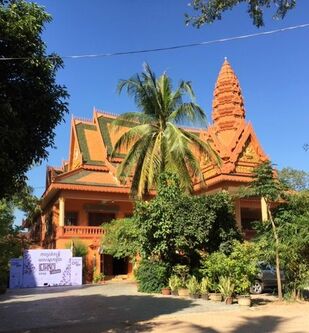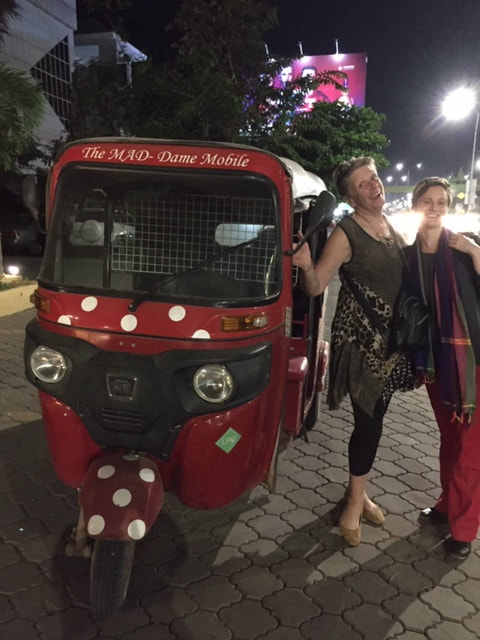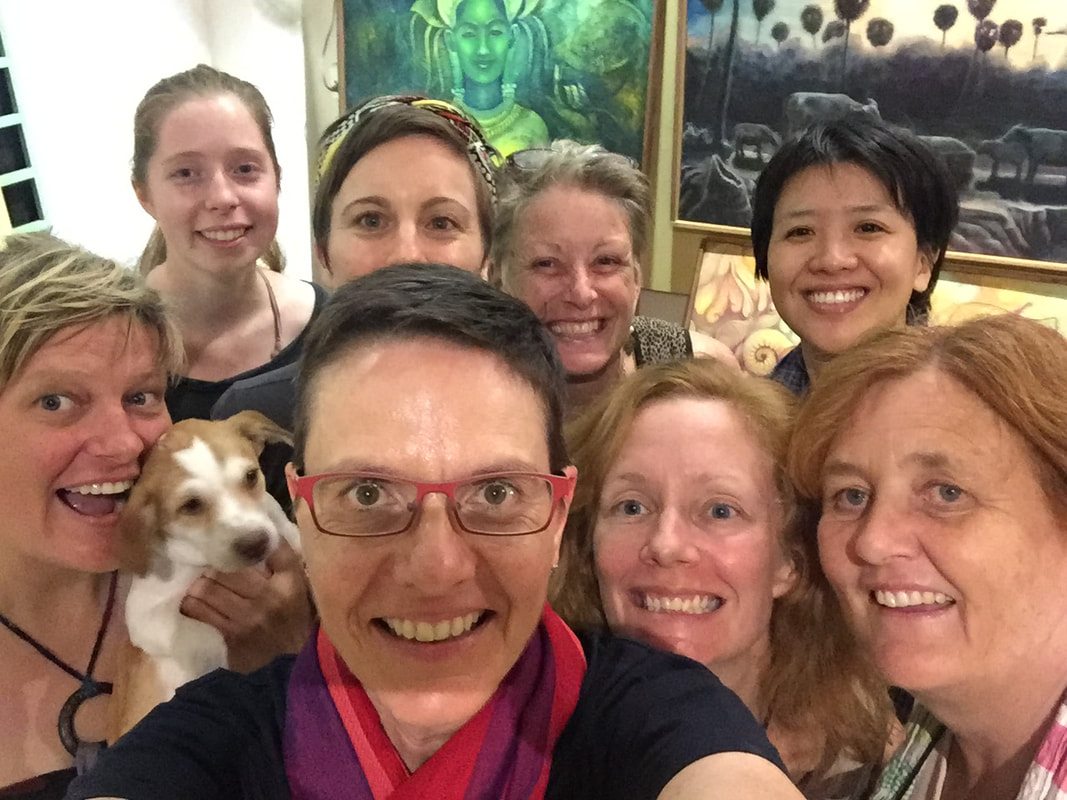Tales of Pacific Pride
 Wat Damnak, site of Cambodian Living Arts' Heritage Hub Wat Damnak, site of Cambodian Living Arts' Heritage Hub Tuesday is a day for double-dating. Apart from our two dates with the LGBTQI community, we also have two dates with arts groups in Siem Reap, at opposite ends of the spectrum in terms of size and reach. The first is with Kai from Cambodian Living Arts, who Mel met at the Bambu Stage on Sunday night. He’s invited us to the Heritage Hub at Wat Bo, an old Buddhist monastery and pagoda in the middle of town. We start by watching an Ethno-Cambodia workshop - for one week, 30 young musicians from around the world, all playing traditional instruments, have come together to teach each other their music. By mid-afternoon they’ve already learned three songs (apparently the Swiss piece was a bit of a challenge for some of the more microtonal instruments), and it’s currently the turn of the Indian team to teach. There’s an amazing array of instruments in the room; some we recognise: drums, guitar, violin, traditional Cambodian instruments and a Japanese sho. There are also five singers. The Indian flautist plays his piece phrase by phrase, each musician learning by ear, some copying tentatively, others with evident gusto. Some annotate small notebooks. The singers have moved to the stage area to learn their part. If they were after quiet, they won’t find it here. You need to be a quick learner in this environment as each teacher only has about 30 minutes. Looking at the different instruments, we wonder how this piece will ever come together, particularly as the tempo dramatically increases. One player, on what appears to be a single-stringed instrument, looks pleadingly at the teacher: 'It's hard to go faster on this instrument, perhaps a little break between verses would help?' But by the time Kai returns for us, the Indian piece is rocking along. Sarah in particular is blown away by the concept. Kai has much more to share with us, though, including the story of Cambodian Livings Arts, whose founder survived the Khmer Rouge by being quick to pick up the national songs they gave him to play. After the regime’s end, he found Cambodian traditional music had disappeared - those musicians who had managed to survive couldn’t make money from their art and had abandoned it. So began CLA’s long quest to rebuild Khmer art and create a living for artists. The female drumming group Medha is just one of their ensembles, and they’re also currently helping the Khmer Magic Music Bus, which travels to rural areas to demonstrate and teach traditional music to kids. (A bit like our Musica Viva program but with a cooler name.) Kai has plenty of suggestions about places we could perform, including at the Heritage Hub, and artists who might perform with us. Personally we love the idea of putting a Rainbow Choir on a Magic Music Bus - it sounds like Enid Blyton meets The Wiggles - but we’re not sure we’re quite the target market! We are definitely at home with our next music appointment however - 6.30pm is time for choir! Yep, you heard right, we’ve actually found a choir in Siem Reap. They’re called the Siem Weep Singers, and they’re run by Deborah Saunders, another Aussie ex-pat who upped stumps and moved here over ten years ago. The choir is currently a small group of expats who get together on a somewhat ad hoc basis to sing easily teachable world music and popular songs. They’re always keen to welcome new voices and tonight, we’re bringing three. In a sign of what a small world it is, Sarah’s friend Diana is also in Siem Reap, supervising nursing students. Sarah and Diana met and bonded over Old and Middle English in the mid-2000s when both writing their PhDs, and have run into each other randomly at Sydney Philharmonia rehearsals where Diana sings and Sarah’s on the roster as an emergency conductor. We’d all planned to have dinner, but Diana is up for a sing before supper, so she joins us there. The Siem Weep Singers (glad to know a good choir pun is an international phenomenon) is a small group of women. The nature of contract work here means that people come for two years then leave. Again it’s a familiar theme. Adam told us earlier that you have to work at staying connected in Siem Reap. People come for two days, two weeks, two months or two years, but after that, they usually move on. We’re welcomed warmly. What a refreshing change from Sydney where it is can be so hard to break into a new group and feel instant rapport. With three extra singers tonight we just about double the size of the group. We sit at a small kids’ table with an array of instruments including a ukulele, bells, and maracas. The group rehearses at the Small Art School, a self-financed art school providing free art education to Cambodian children. The associated gallery sells the kids' artwork and the money raised is split three ways between the artist, gallery operating costs and funding for the education program and art materials. Through this work, not only is the gallery the providing kids with an opportunity to make a living from their art, it’s also providing them with much needed business skills. The plastic choir folders are bursting with songs and lyrics. Over the years those who have joined have left songs to add to the collection. Deborah plays the ukulele and sings all the parts for us to copy. We have quite a few songs in common; maybe the Siem Weep Singers can join us for an item in July? We have great fun, and puppy cuddles from wrinkly little Tulsi, choir member Nicole’s seventh adoptee (she volunteers at one of only three vet clinics in town). Sarah’s invited to leave a song with the group and teaches Freedom Train. After dinner together at the local Thai, Deborah drives us home in her red-and-white polka-dotted tuk-tuk, christened ‘The MAD-Dame Mobile’. Anyone looking for a song in their heart and a spring in their step in Siem Reap should look her up.
0 Comments
Leave a Reply. |
Mel & Sarah
Currently blogging from home, in iso like everyone else, and catching up with PPC19 in the form of a daily photojournal. Archives
June 2020
Categories
|
Proudly powered by Weebly


 RSS Feed
RSS Feed